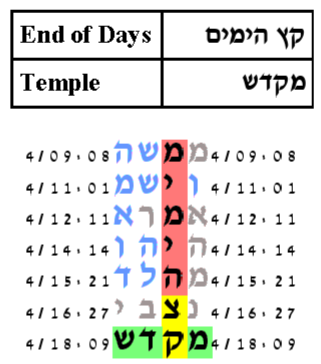| Home»The Messiah Prophecy» The Third Temple |
The Messiah Prophecy: The Third Temple
The first temple was the one that King Solomon built and it stood until 586 B.C.E. when it was destroyed by Nebuchadnezzar. King Darius Hystaspes permitted the rebuilding of the temple began in 519 B.C.E. The second temple was completed about three years later and stood until the year 70 A. D. when the Romans burned it.
One of the themes of the Messiah Prophecy is the rebuilding of the Temple. Come and hear the prophet Isaiah.
It will happen at the end of days. The mountain of the Temple of Hashem will be firmly established as the head of the mountains, and it will be exalted above the hills, and all the nations will stream to it. will go and say,
Come, let us go up to the Mountain of Hashem, to the Temple of the God of Jacob, and He will teach us of His ways and we will walk in His paths.
For from Zion will the Torah come forth, and the word of Hashem from Jerusalem. (Isaiah 2:2-3)
Listen to the prophet Ezekiel.
I will seal a covenant of peace with them [the children of Israel] and it will be an eternal covenant with them; and I will emplace them and increase them, and I will place My Temple among them forever. My dwelling place will be among them; I will be a God to them and they will be a people to Me. Then the nations will know that I am Hashem Who sanctifies Israel when My Temple will be among them forever. (Ezekiel 37: 26-28)
The temple that Isaiah and Exekiel speak about is the third temple. In chapters 40 through 43, Ezekiel describes the architectural details of the eternal Sanctuary of Hashem as it will be at the time of the Messiah.
It is natural to combine together the key words: The Third, (The) Temple, and Messiah. With expected number of ELSs set to 30, the probability that a text from the ELS random placement text population would produce as small an area table as that produced by the Torah text is 36.5/1,000.
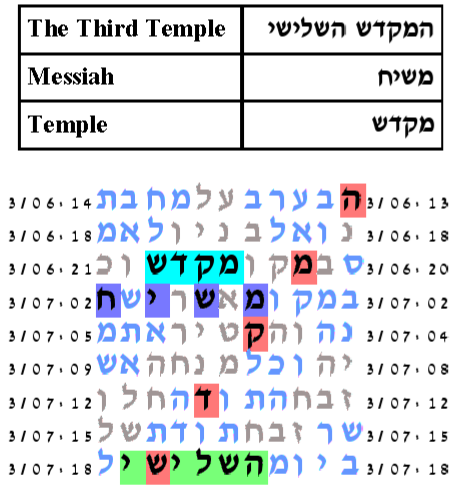
There also is a statistically significant table switching the definite article Messiah: Third, Temple, and The Messiah. With expected number of ELSs set to 20, the probability that a text from the ELS random placement text population would produce as small an area table as that produced by the Torah text is 51.5/1,000.

The Messiah is referred to as the son of David or as the son of Jesse, the father of David. We use the key words Messiah, son of David, and Temple. We set the expected number of ELSs to 10. The probability that a text from the ELS random placement text population would produce as small an area table as that produced by the Torah text is 17.5/1,000.
The verses running through the last four rows of the table are relevant to the topic.
You shall sanctify yourselves and you will be holy for I am Hashem, your God. You shall observe My decrees and perform them -- I am Hashem, Who sanctifies you. (Leviticus 20:7-8.)
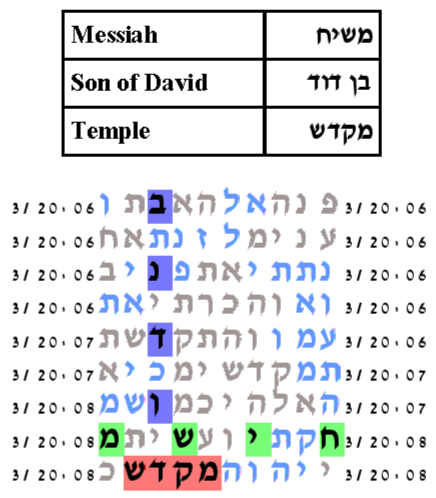
The father of King David is Jesse. Using son of Jesse in place of son of David in the above key word set did not produce a statistically significant result. However there is an interesting table involving the key words son of Jesse, Third Temple, and The Messiah. With expected number of ELSs set to 20, the probability that a text from the ELS random placement text population would produce as small an area table as that produced by the Torah text is 2.5/1,000.
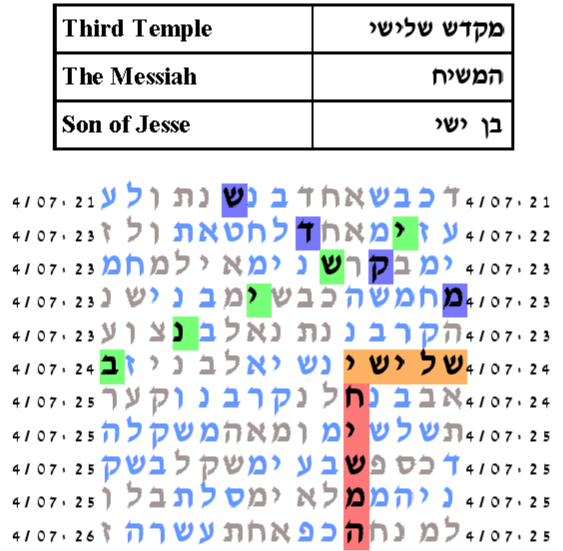
Adding the key word third to the above key word set produces an interesting table. With the expected number of ELSs set to 100, the probability that a text from the ELS random placement text population would produce as small an area table as that produced by the Torah text is 9.5/1,000.
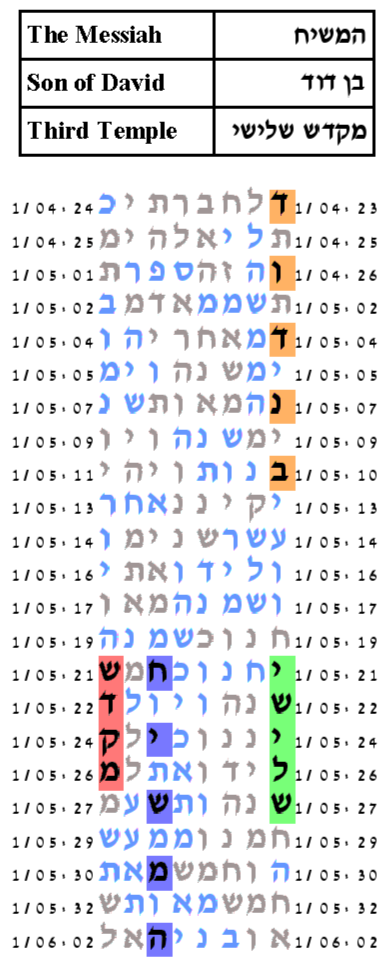
This table is interesting because it has some additional relevant ELSs. In the table is an ELS for on Moriah. Mount Moriah is the place of the Temple. And there is in the text itself it will comfort us. The developed table is shown below.
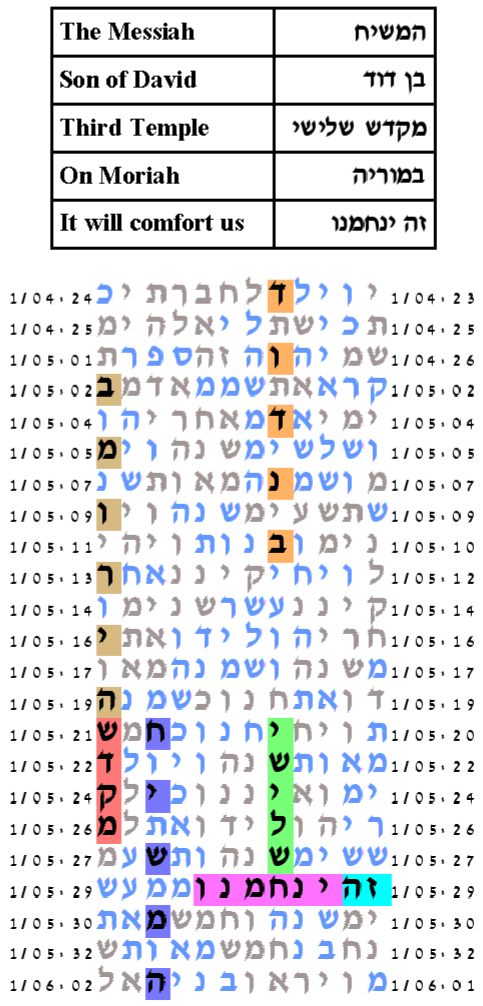
One might wonder that since none of these tables had an exceptionally small p-level, whether the results as a whole are statistically significant when taking into account all the possible combinations of key words. Setting the expected number of ELSs to 30, we tried a combined experiment that used all 20 key word sets that had at least 3 key words and had to include Messiah and Temple, either with and without the definite article. The combinations included taking: Messiah or The Messiah; Temple, The Temple, Third Temple, or The Third Temple; Son of David, Son of Jesse, or neither. The total number of combinations is therefore 2x4x3=24. But 4 of these combinations involve only 2 key words, so the experiment used only 20 of the 24 that had 3 or more key words. The probability of the combined result being as good as that found in the Torah text is 29.5/1,000. This is not as significant as what one might want. This could be because these are only supporting tables. It could be because for a combined experiment our current software must have the expected number of ELSs set the same for all key word sets and by setting the expected number of ELSs to 30 we miss the table which needed the expected number of ELSs set to 100. Or it could be because when we set up the experiment we did not think of a key word that is part of these tables. Nevertheless, this is the result using only a small number of central key words. At some time we might return to this data set and explore it for additional key words that are in the tables.
There are two Biblical Hebrew expressions for End of Days: קץ הימים and אחרית הימים. We pair each one with the key word Temple. The first pairing has a significant meeting. With the expected number of ELSs set to 10, the probabiilty that a text from the ELS random placement text population would have as small an area table as that produced by the Torah text is 29/10,000. We did two experiments and by the Bonferroni, the upper bound on the p-level is 58/10,000.


 Documentaries and Tutorials
Documentaries and Tutorials
